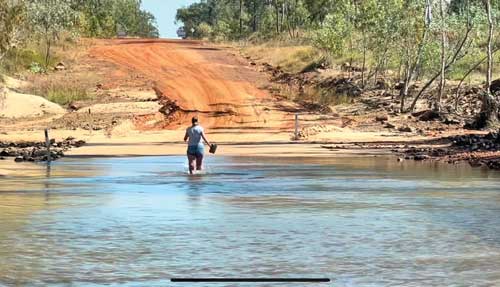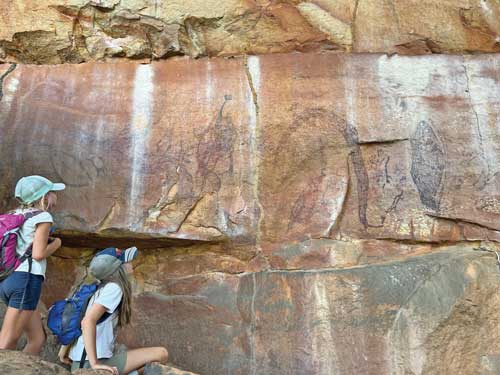Each year the condition of the Gibb River Road is mostly unknown.
Factors such as rain and traffic impact the road dramatically.
Generally, it is better to hit the Gibb either early in the season or when it has reopened after the wet, as it will have been recently graded.
Though it should still be attacked with caution.
We passed two camper trailers on the side of the road that were broken and had been left by their owners.

I feel we were relatively lucky in that the road conditions weren’t too bad.
That didn’t mean we were impervious to any issues – a bolt did come out of the suspension of our JB Scorpion caravan.
Thankfully, Drysdale River Station had a mix of spare parts, which allowed me to rectify the situation, enough so we could continue and then have it replaced in Kununurra.
Manning Gorge
Located on Manning Creek in the grounds of the 283,280ha Mt Barnett Station, Manning Gorge would have to be one of the prettiest gorges in the Kimberley.
The vivid colour of the rock cliffs and the crystal-clear water produce a picture-perfect postcard that typifies the Kimberley region.

Getting to the gorge requires an adventurous walk, starting with a river crossing at the end of the caravan park.
We needed to swim across the creek because there had been plenty of rain.
Thankfully blue drums were available for putting our gear into, keeping it dry when we were crossing the creek.
Once across, we were then faced with a 3km hike to the top of the gorge.
At the start of the hike, the trail was relatively informal and required a bit of thinking to keep moving in the right direction – there were occasional markers to help guide us, but a keen eye was needed to spot them.
The trail was overland and encompassed uneven terrain and rock climbing, with a steep decline at the end of the hike to get to the base of the gorge.

This was a semi-challenging trek, yet the rewards were definitely worth the effort – particularly the dip in the water and the massage from the waterfall.
This track was exposed with no shelter from the sun, so it is important to take plenty of water.
Drysdale River Station
If you are after some creature comforts, Drysdale River Station is the spot for you.
We stayed in the caravan park for a night, however if required, rooms were available.
As we were more than happy living in our van, with all the basic comforts of home, we didn’t need to stay anywhere else.

However, we did meet other travellers who were having issues with pumps, batteries and fridges, so a night or two away from their van was appreciated.
In addition to accommodation, there was a beer garden and dining area, plus fuel, a small general store and a tyre repair facility.
If you are on the Gibb and need something, Drysdale River Station is the place to go – if it’s not available there, you will have to make it the rest of the way along the Gibb without it.
Munurru (King Edward River) Campground
One place we were all excited to see was Mitchell Falls.
In order to visit the falls, you need to either drive in – which is not recommended with large caravans – or stay at Munurru (King Edward River) Campground.
We chose the latter.

The road in from Drysdale River Station was rough – make sure to keep an eye on your tyre pressure.
It was also fairly dusty, so I advise taping your vents up.
Our JB Scorpion had a dust reduction system fitted, which was a great investment because it kept 99 percent of the dust out.
Yet we still taped up a few sections, just to make sure we weren’t treated to a red interior after the drive.
I’d highly recommend getting a DRS if you’re planning to travel on dusty roads – it is worth the money.

The booking system at Munurru Campground is relatively informal – you put cash in an envelope.
We also had to pay a cash fee at Drysdale River Station to use the road, so make sure you have physical funds with you.
Thankfully not many people were at the campground, so we had our pick of camping spots.
The plan was to stay a couple of nights and do a massive day travelling Mitchell Falls without the van.
It is worth noting that there were a few creek crossings before reaching the campsite, with one a little deeper than expected, so make sure you get out and check them before attempting to cross.

It is also a good idea to do most of your driving during the day because it makes creek crossing a lot easier, plus there are less animals on the road.
One feature we missed when researching this campground was the large pool you can swim in.
This was a welcome relief after being on dusty roads – just what the girls and I needed.
And it meant we used less water for showering – a win-win situation.

Wandjina and Bradshaw rock art
I am sure there would be many places within the Kimberley that have spectacular rock art by Indigenous people, however most are possibly never seen by white folk.
This is understandable as quite a few scared sites cannot be visited.
However, there are two areas in Munurru where you can walk around the Kimberley and search for Aboriginal art.
Apparently, it is also possible to organise a tour, however we were not sure how to do that – information regarding it was limited – so we embarked on the trails ourselves.

It was still great to see a number of paintings at both places, yet it would have been good to have an indication of the meaning behind the artwork.
There are no signs, apart from a fence with an opening, so you follow what resembles a trail as you go in search of the art.
On our adventure, we saw plenty of Indigenous rock paintings, though I was always keen to see more.
Next month, the adventure continues to Mitchell Falls and remainder of the Gibb, as we make our way to El Questro Station and cross the infamous Pentecost River.
 Bush ‘n Beach Fishing Magazine Location reports & tips for fishing, boating, camping, kayaking, 4WDing in Queensland and Northern NSW
Bush ‘n Beach Fishing Magazine Location reports & tips for fishing, boating, camping, kayaking, 4WDing in Queensland and Northern NSW









